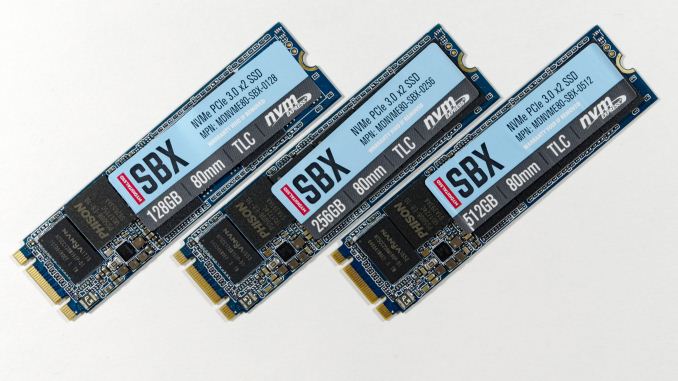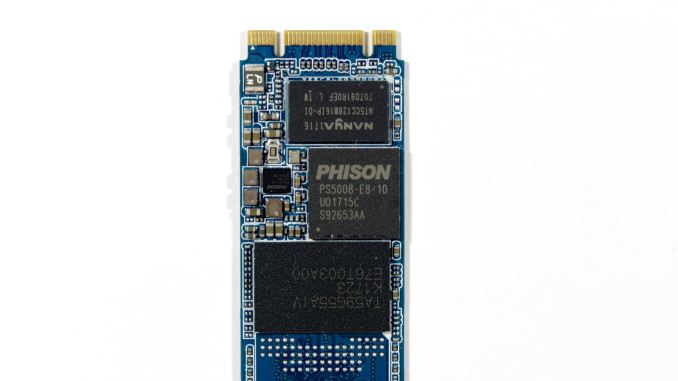The MyDigitalSSD SBX SSD Review: NVMe On The Cheap
by Billy Tallis on May 1, 2018 8:05 AM EST
MyDigitalSSD's business model revolves around selling drives based on Phison reference designs. Like any other small SSD brand, MyDigitalSSD lacks the resources to develop their own SSD controller or even write their own firmware from scratch. The way MyDigitalSSD distinguishes themselves from the many competing brands is by offering drives for substantially lower prices and by being one of the first to market with new controllers from Phison. The SBX checks both boxes: it is priced below the Samsung 860 EVO SATA SSD, and it hit the market in December 2017 as the first Phison E8 drive to ship and one of the earliest retail SSDs to feature Toshiba/SanDisk 64-layer 3D NAND.
As one of the cheapest NVMe SSDs on the retail market, the MyDigitalSSD SBX is a good indicator of the progress NVMe drives have made toward replacing SATA SSDs instead of merely coexisting as a premium high-end alternative.
The Phison E8 controller is one of Phison's low-end options from their second generation of NVMe SSD controllers. The E8 features just two PCIe lanes instead of the usual 4 enabled by an M.2 slot, and a four-channel interface to the NAND—half what is typical for high-end NVMe SSDs. These restrictions combined with a 40nm fabrication process allow the E8 to be a much smaller and cheaper controller than those aiming for the high-end part of the market. To cut costs even further, drive makers can opt for the Phison E8T variant that drops the external DRAM interface. The E8T supports the NVMe Host Memory Buffer feature to mitigate the performance impact DRAMless SSDs usually suffer from, but the E8T hasn't caught on in the consumer SSD market yet.
Despite its low-end role, the Phison E8 is in several ways more advanced than Phison's E7, their first NVMe SSD controller. Major improvements to the error correction capabilities have allowed the E8 to support 3D TLC NAND instead of being confined to the 15nm planar MLC used by E7 drives. The E8 and E8T controllers will also be joined by a high-end E12 controller later this year to round out Phison's second generation of NVMe controllers.
| MyDigitalSSD SBX Specifications | |||||
| Capacity | 128 GB | 256 GB | 512 GB | 1 TB | |
| Form Factor | M.2 2280 | ||||
| Interface | PCIe 3.1 x2, NVMe 1.2 | ||||
| Controller | Phison PS5008-E8 | ||||
| NAND | Toshiba BiCS3 64-layer 3D TLC | ||||
| DRAM | DDR3 | ||||
| Sequential Read | 1600 MB/s | ||||
| Sequential Write | 1300 MB/s | ||||
| 4KB Random Read | 240k IOPS | ||||
| 4KB Random Write | 180k IOPS | ||||
| Max Power | 5 W | ||||
| Write Endurance | 120 TB 0.5 DWPD |
200 TB 0.4 DWPD |
375 TB 0.4 DWPD |
800 TB 0.4 DWPD |
|
| Warranty | 5 years | ||||
| Amazon Price | $52.99 (41¢/GB) | $84.99 (33¢/GB) | $157.99 (31¢/GB) | $309.99 (30¢/GB) | |
This review will primarily compare the SBX against other recent NVMe SSDs, but a few SATA results are included for context. As the cheapest NVMe SSD we have tested so far, the SBX isn't quite in direct competition to all the NVMe SSDs it is being compared against. We have other low-end NVMe SSD reviews in the works including Kingston's A1000 (their take on the Phison E8 platform), and the HP EX900 featuring Silicon Motion's low-end SM2263XT controller. ADATA's SX6000 is the main alternative to the SBX for a NVMe drive in this price range, but we have not had the chance to test the SX6000 or any other drives using Realtek's SSD controller.
We did not test the MyDigitalSSD BPX, the SBX's predecessor based on the Phison E7 platform with 15nm planar MLC NAND. Instead, we have results from the Patriot Hellfire and Team T-Force Cardea, two other M.2 drives based on the same reference design.
| AnandTech 2017/2018 Consumer SSD Testbed | |
| CPU | Intel Xeon E3 1240 v5 |
| Motherboard | ASRock Fatal1ty E3V5 Performance Gaming/OC |
| Chipset | Intel C232 |
| Memory | 4x 8GB G.SKILL Ripjaws DDR4-2400 CL15 |
| Graphics | AMD Radeon HD 5450, 1920x1200@60Hz |
| Software | Windows 10 x64, version 1709 |
| Linux kernel version 4.14, fio version 3.1 | |
- Thanks to Intel for the Xeon E3 1240 v5 CPU
- Thanks to ASRock for the E3V5 Performance Gaming/OC
- Thanks to G.SKILL for the Ripjaws DDR4-2400 RAM
- Thanks to Corsair for the RM750 power supply, Carbide 200R case, and Hydro H60 CPU cooler
- Thanks to Quarch for the XLC Programmable Power Module and accessories
- Thanks to StarTech for providing a RK2236BKF 22U rack cabinet.

















46 Comments
View All Comments
MajGenRelativity - Tuesday, May 1, 2018 - link
The price premium of lower-end NVMe SSDs forms a big part of their problem in my head. When I build a computer for somebody, I usually use an M.2 SATA SSD if I include an SSD, because SATA SSDs are the cheaper alternative, and most people won't use the performance of an NVMe SSD. If they *do* need the performance of NVMe, I find it a little hard to justify stopping at the low end when they can pay a bit more and bump up the performance by quite a lot. My thoughts are that while products like the SBX are a step in the right direction, they really need to match SATA drives in price to become fully worthwhile.Dribble - Tuesday, May 1, 2018 - link
The other thing they have going for them is size. I can see a cheap nvme being used quite a bit in mid range laptops that came with a SATA disk but have a spare nvme slot. For desktops not only does the drive sit flush with the motherboard mostly, but it requires no cabling and no hd cage to put it in. I could see myself getting one as a second drive - it's not like I'd really be able to tell it's any slower then a high end drive for standard desktop usage.Dribble - Tuesday, May 1, 2018 - link
Ah didn't read the previous comment carefully enough "M2 SATA SSD" not "SATA SSD", never mind.MajGenRelativity - Tuesday, May 1, 2018 - link
Yeah. I can see 2.5" SATA going away entirely / being replaced by 2.5" U.2, but M.2 SATA still has a place for meeek2121 - Wednesday, May 2, 2018 - link
My current machine no longer has any type of SATA drive in it. I have a single 1TB Samsung 960 EVO. I thought about going going for the pro or a 2 TB EVO, but this fits my needs perfectly. Now if we could just get a mini-itx threadripper board... ;)MajGenRelativity - Thursday, May 3, 2018 - link
For me, I need bulk storage, so SATA isn't going away any time soon. However, I don't think Mini-ITX Threadripper will happen, as the socket is too bigRatman6161 - Monday, May 7, 2018 - link
Price wise, for a lot of people in your situation, you could get the 500 GB 960 EVO for $200 and also the 1 TB MX500 for $249. That would give you a total of 1.5 TB for the price of a 1 TB 960EVO. Then EVO could then be used for OS and programs with some data while the cheap but still pretty good MX500 could provide the big storage.gglaw - Saturday, May 19, 2018 - link
The popular budget Micron 3D TLC 2TB drives are on sale all the time from $280-$300 range. They don't have much marketing or even a fancy name associated with them, come in a bare OEM type box but the few reviews out are all favorable. I have one as a secondary storage drive with a 960 EVO 500GB boot drive but tbh when I moved my Steam library over to it, I can't even tell the difference in performance between it and the NVMe EVO.https://www.amazon.com/Micron-1100-SATA-2-5-inch-M...
that's the drive but it goes on sale lower than that pretty much every week.
wumpus - Tuesday, May 1, 2018 - link
Why eat the slot? Do your clients get grumpy if they see and "old fashioned" 2.5" drive? I'd rather leave the M.2 slot waiting for a card that really needs it, and still have the SATA drive connected.MajGenRelativity - Tuesday, May 1, 2018 - link
I sell to a variety of clients (I co-own a small business so we cover all sorts), and usually they don't have enough technical knowledge to know the difference between a 2.5" drive and M.2. I use the M.2 slot because it allows me to either disconnect the SATA cable (for a modular PSU), or tuck it out of the way to increase airflow. Most of my customers won't need the performance boost of upgrading to an NVMe drive, so it hasn't been a problem before. In the cases where that is a viable upgrade path, I discuss it ahead of time, and do use a 2.5" drive in situations where necessary/desired.